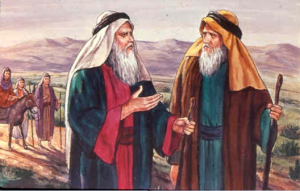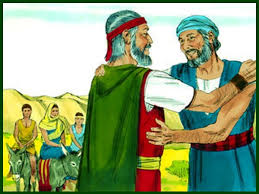Tetzaveh 2016 – Brotherly Love
by devadmin | February 18, 2016 8:09 pm
Brotherly Love
Shoin: a few decades back, the umois ho’oilom (goyim) used to have two days off in the month of February. One marked the birthday of George Washington and the other was set aside for Abraham Lincoln. Their days were combined into what we now call Presidents Day which was marked this past Monday by taking a day off from work, from banking and by shopping for yet more clothing and shmattis. Clothing are featured in this week’s parsha. Ober for us Yiddin, Tuesday was the big day as it marked the birthday and according to many, also the yurtzeit of the passing of Moishe Rabaynu who died at the ripe old age of 120, the maximum allowed. How did we mark that day? We didn’t; doesn’t he deserve better?
They say that flattery will get you everywhere; they are correct! Among the many comments received this week, we will begin with one from Chaim Beregovsky who wrote azoy.
Dear Reb Yitz,
You are well known in the Five Towns and now just as well known on the web! mazel tov!!
Something have been meaning to ask, and feel like can only ask you this, not any regular rebbe in the shul, etc. it just feels like all the descriptions and measurements in today’s parsha are not really meant to be taken literally but are rather part of some mystical description of connecting to Hashem, and then when you do it “tabernacle becomes One”, something clearly referring to the RBSO. have you ever considered that these names of materials and measurements are not really what they appear to be, but rather some deeper mystical references?
Thank you kindly for making these posts available online, your loyal reader for years!
Chaim Beregovsky
Reb Chaim, whoever you are, your comment was selected for two reasons. Ershtens, as mentioned above, you mamish flattered the Oisvorfer and that’s not a bad way to start. Moreover, your question was good. So happens that serious thought was mamish given to writing about that very topic this past week, ober, the Ruv got sidetracked with other topics of interest which resulted in kimat 80,000 clicks on the website this past Thursday night and Friday. Fortuitously, your comment remains relevant a week later; let’s discuss it in even broader strokes before we zero in on your specific question.
Isn’t it interesting that we orthodox Yiddin mamish need and rely on Toirah She-ba’al-Peh (the Oral Tradition) to help us clarify most of the taryag mitzvois? How many folios have been written and how many discussions and arguments have ensued over the generations trying to chap what the RBSO had in mind when He gave over most of the mitzvois? Too many! When it comes to interpreting certain mitzvois, we continue these disagreements ad hayoim hazeh (until today) and there are usually several opinions. It’s seemingly part of our tradition. Without the heylige Mishne and Gemora, how would we know how to keep the heylige shabbis which is mentioned numerous times in the heylige Toirah? And how would we know not to take out the eye of a person that blinded someone? How to build a succha? What an esrog is? And the list goes on. It’s endless, mamish! Therefore, we Yiddin are taught to believe that the oral tradition was mamish given over to Moishe so that he could teach us how to properly perform the taryag (613 commandments) mitzivs. Oral traditions are always good, if you chap. And taka that all makes sense. Until….we got to last week’s parsha of Teruma wherein the RBSO not just gave instructions for a sanctuary He wanted the Yiddin to build Him, but was also very detailed about its dimensions and more. His instructions for the Mishkan and other appurtenances came with precise measurements and detailed blueprints.
 Did the Yiddin get similar detail with the Ten Commandments? Negative. With the 53 mitzvis taught back in Mishpotim? Also negative. With the overwhelming majority of the other mitzvis still be taught? Also not! So happens that the Oisvorfer can only recall one other parsha where specific measurements were given and they do not pertain to the observance of a mitzvah. Let’s harken back, way back, to parshas Noiach and the building of Noiach’s Teyvo (Ark). There, Noiach was told how to build his Ark. It’s exact length, width and height are revealed. Details, including the placement of the window or skylight was reduced to writing. Let’s now return to last week’s parsha of Teruma where the RBSO gave Moishe very specific plans for the Ark, Mishkan (Tabernacle), and the Shulchan. And the dimensions, as Chaim mentions in his comment, included whole and fractional ammos (cubits: what a cubit was/is, we shall soon attempt to see). The RBSO was just as particular and precise about the building materials, the fittings, the finishes and the interior design. He wanted specific fabrics and colors. It was to be His house; He had very particular taste, why not?
Did the Yiddin get similar detail with the Ten Commandments? Negative. With the 53 mitzvis taught back in Mishpotim? Also negative. With the overwhelming majority of the other mitzvis still be taught? Also not! So happens that the Oisvorfer can only recall one other parsha where specific measurements were given and they do not pertain to the observance of a mitzvah. Let’s harken back, way back, to parshas Noiach and the building of Noiach’s Teyvo (Ark). There, Noiach was told how to build his Ark. It’s exact length, width and height are revealed. Details, including the placement of the window or skylight was reduced to writing. Let’s now return to last week’s parsha of Teruma where the RBSO gave Moishe very specific plans for the Ark, Mishkan (Tabernacle), and the Shulchan. And the dimensions, as Chaim mentions in his comment, included whole and fractional ammos (cubits: what a cubit was/is, we shall soon attempt to see). The RBSO was just as particular and precise about the building materials, the fittings, the finishes and the interior design. He wanted specific fabrics and colors. It was to be His house; He had very particular taste, why not?
The instructions given in parshas Tetzaveh, are no different. The RBSO will instruct Moishe (without mentioning his name even once in the entire parshas, a topic previously covered: check out archives at www.oisvorfer.com), to have a line of clothing designed and sewn for Aharoin and his boys. It was to be the first ever ‘Koihen designer line.’ Says the heylige Toirah (Shemois 28:2) azoy: “And you shall manufacture holy garments for Aharoin your brother, for glory and for splendor.” Aharoin was being promoted. Says the Oznayim LaToirah: the ‘bigdei kihuna’ needed to be new and smart. And says the Rambam (Hilchois K’lei haMishkon) azoy: the clothing may not be dirty, torn, too long or too short. The koihanim needed to wear the specified items, all of them. Moreover, should the koihen perform the Avoidoh (service) with any of these shortcomings, the service was posul (worthless).
The RBSO did not want His Koihanim dressed in stam cheap shmattis and delineates to Moishe the specific materials and just how each of the Koihen’s vestments are to look. No fewer than 43 pisukim are dedicated to the kihuna collection. So detailed and precise were the instructions that one could mamish fashion them just from reading the text of the parsha which colorfully describes each beged (article of clothing). No further elucidation from the Mishne was required. In fact, some Toirah inspired entrepreneur did just that in booklet form. When we were kinderlach, this booklet was called ‘Bigday Kihuna’, it cost a total ten cents and we loved looking through the pages. Today, these editions are available in color, avada not for ten cents.
And the question is azoy: Why was it that the RBSO was rather vague about the great majority of the mitzvis found in the heylige Toirah, especially about the laws of kosher, proper shabbis observance, and yet, was so detailed when it came to construction and decorating projects? And asks Chaim, what about those fractional measurements: were they real and exact? Or, are they meant as but guideposts? Shoin, the Oisvorfer was taka left scratching his head and went looking for real pshat in these questions. And while a few do offer answers on the significance of the fractional measurements, most are what we call gikvetched (forced). None were very satisfying and none addressed the disparity between the lack of detail concerning the laws of kosher, shabbis and more, to the very colorful and precise details when it came to the construction project, interior decorating and a fashionable clothing line. Was the RBSO trying to inspire this line of work? Was He hinting that construction, design and interior decorating were also noble professions? Was this a wink to those who showed little interest in learning? Maybe! Or, maybe farkert (opposite)?
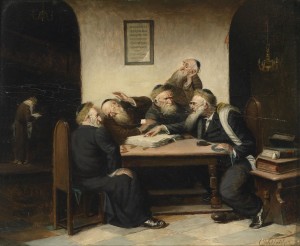 Shoin, what you are about to read is mamish Oisvorfer pshat and if any rabbi or layman reading this review has a better explanation, or wants to shlug it up (bat it down), please avada send in your comments. Grada this pshat is antithetical to the Oisvorfer’s hashkofo, ober, since it’s efsher real pshat -go prove otherwise- it is being shared. Here we go: Can pshat be that the RBSO was signaling that He davka wanted us to spend the great majority of our time huriving (toiling and arguing) over real pshat in the great majority of His Commandments and less time over mundane projects such as clothing design and other building projects? Maybe! And efsher that’s why He provided the details, every last one, when it came time for mitzvis which took the Yiddin away from arguing and studying the heylige Toirah. He made it easy. Down to fractional measurements. Ober, to figure out the shabbis and other mitzvis, He davka wanted us to sit, study, learn and argue. Ver veyst? Go prove otherwise!
Shoin, what you are about to read is mamish Oisvorfer pshat and if any rabbi or layman reading this review has a better explanation, or wants to shlug it up (bat it down), please avada send in your comments. Grada this pshat is antithetical to the Oisvorfer’s hashkofo, ober, since it’s efsher real pshat -go prove otherwise- it is being shared. Here we go: Can pshat be that the RBSO was signaling that He davka wanted us to spend the great majority of our time huriving (toiling and arguing) over real pshat in the great majority of His Commandments and less time over mundane projects such as clothing design and other building projects? Maybe! And efsher that’s why He provided the details, every last one, when it came time for mitzvis which took the Yiddin away from arguing and studying the heylige Toirah. He made it easy. Down to fractional measurements. Ober, to figure out the shabbis and other mitzvis, He davka wanted us to sit, study, learn and argue. Ver veyst? Go prove otherwise!
Had the RBSO been so exact with the other mitzvis, He could have saved many of us years in yeshiva -which most of us davka hated- fewer encounters with rouge rebbes who had penchants for hands-on teaching, if you chap, less trauma, and zicher less time huriving over the folios of the heylige Gemora. Moreover, we wouldn’t be arguing with the non-believers about the validity of the entire Toirah she-ba’al peh. Seemingly, that’s not what He or the yeshivas wanted. How would they justify years of outrageous tuitions? Maybe it was His plan to find gainful employment for yeshiva administrators, rebbes and other staff? Why not? Didn’t the RBSO intended for all his Chosen People to make a decent living? Avada He did! And what better vehicle than the heylige Toirah.
Shoin, let’s now discuss Chaim’s kasha about fractions. Let’s see what some had to say. Again, none very satisfying but here we go. Said Rabaynu Bachya and the Ba’al Haturim azoy: the fractional measurements of the Ark teach us that Torah scholars must be humble and not arrogant. They do? And said the Kli Yokor: the fractions hint that a person must view himself as being incomplete in his Toirah knowledge. A few other commentators toe the line and suggest a connections between fractional dimensions and some form of humility and incompleteness, ver veyst. It so happens that a shtikel answer might be found in the Oznayim Latoirah who said azoy: Philosophically we might kler that the RBSO used fractional measurements, specifically 1/2 when it came to the Ark to send us this message. As we all avada know, the Ark was meant to house the heylige written Toirah (Toirah she’bichsav). That however makes up only 1/2 of the Toirah. It is complemented by Toirah she-ba’al peh (oral tradition), which we have been discussing above. The fractional measurement was given to teach us that the Toirah is only complete when complimented with its other half, the oral tradition; together they make up the entire Toirah. Gishmak!
On the other hand, how exact were those measurements? Is it taka emes that the RBSO’s instructions were perfectly clear? Or, did they require some further clarification and subsequent discussion? And why do we ask? Because it’s taka emes that He told Moishe to build the Ark 2.5 Amos x 1.5 Amos x 1.5 Amos, ober did He ever tell us what an ‘Ammo’ was? Not! What is an Ammo (cubit)? How many inches or feet? Nu, to solve that part of the puzzle, we need to go back to the oral tradition and to see what a few had to say. One thing is certain: the heylige Toirah did not tell us! Avada size matters, so some say, if you chap, and it’s mashma (appears) that not all were in agreement as to its size. The size of an ‘Ammo’ was not universal; it changed over time and even today, one will find different answers for its size. Veyst zich ois (seemingly), inches matter.
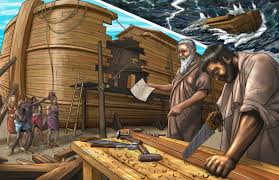 Now if you recall, the first time we met the Ammo was back when Noiach was given instructions to build himself an Ark. Does the heylige Toirah there define the Ammo? No! One medrish will tell us that an Ammo was a minimum of 18 inches and using that figure, guestimated the absolute minimum dimensions of the Teyvo (Noah’s Ark). Similarly, when it came to building the Mishkan project, Moishe was given whole and fractional dimensions, ober was not told how large the Ammo was. Shoin.
Now if you recall, the first time we met the Ammo was back when Noiach was given instructions to build himself an Ark. Does the heylige Toirah there define the Ammo? No! One medrish will tell us that an Ammo was a minimum of 18 inches and using that figure, guestimated the absolute minimum dimensions of the Teyvo (Noah’s Ark). Similarly, when it came to building the Mishkan project, Moishe was given whole and fractional dimensions, ober was not told how large the Ammo was. Shoin.
And again we ask, how long or wide was an Ammo? Is it 18″, maybe shorter, or efsher longer? One source suggests the ammo was as short as 17.5 “, while others tell us the Ammo was 20.3″ and still others, insist that the ammo comes in at 25.6”. Settled? Not! Says rabbi Art Scroll, a more contemporary achroin (commentator) azoy: “Estimates of a cubit range from 18 to 24 inches. For the sake of simplicity, it is common to refer to a cubit as being two feet.” Many agree that in Noiach’s time, the Ammo was mistama not less than 18″, ober over in the Novee Yichezkel (Ezekiel) 40:5, we will find that the ammo was 20.4″. Ok, Reb Chaim: do you chap how flexible measurements were back then? We can kler that the Ammo was mistama somewhat flexible during the Mishkan project as well. Did the RBSO make rulers available to the various craftsman that were in charge of building the Sanctuary and its appurtenances? Maybe and why not? He made many other items appear magically in the midbar wonderland, why not a ruler? Some, including Wikipedia and a few other such sources say that an Ammo is measured from the elbow to the tip of the middle finger. Shoin, given that not every person has the same size elbow or fingers, especially the middle finger, it’s easy to chap that an Ammo’s true dimensions were not quite universal and mistama required some flexibility.
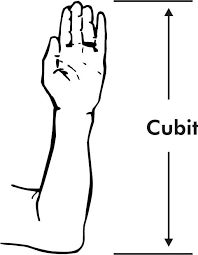 And the bottom line: the Oisvorfer’s theory a few paragraphs back about the RBSO not wanting us to waste too much time while hocking, designing and decorating, is mamish out the window. Once again, like in all other mitzvis, to chap pshat, we are forced back to Toirah- she-ba’al peh (oral tradition) for the correct answer, or more precisely stated, a few possible correct answers. Veyter.
And the bottom line: the Oisvorfer’s theory a few paragraphs back about the RBSO not wanting us to waste too much time while hocking, designing and decorating, is mamish out the window. Once again, like in all other mitzvis, to chap pshat, we are forced back to Toirah- she-ba’al peh (oral tradition) for the correct answer, or more precisely stated, a few possible correct answers. Veyter.
Shoin, we titled this week’s review ‘Brotherly Love’ ober why? And we also mentioned (again) that Moishe’s name does not appear in the entire parsha as is well known. Ober, where in the heylige Toirah have we ever encountered brotherly love? When, since the world was created, did we encounter brothers that mamish loved and cared for one another? Zicher not Kayin and Hevel and zicher not Yaakov and Eisav. Let’s not even mention Yoisef and his holy brothers. In fact we haven’t met any. We met them nowhere! That is until this week’s parsha. Grada, Moishe’s absence (by name only) is quite ironic because it’s in this very parsha where his brother Aharoin is elevated to the kihuna (priesthood) and the story of his promotion directly involved reciprocal love between Moishe and his older brother Aharoin.
Says the heylige Gemora (Shabbis 139a) azoy: when the RBSO was negotiating with Moishe to accept the leadership position and head back to Mitzrayim to help free the Yiddin from slavery, Moishe was reluctant, very. Efsher you recall that the RBSO and Moishe were locked into negotiations for seven days. Ober why was Moishe reluctant to do the RBSO’s bidding? Says the heylige Gemora so gishmak, azoy: Moishe was concerned with Aharoin’s feelings, he did not want to offend his older brother. You hear this? Moishe felt for his older brother and thought Aharoin might be a shtikel jealous over the success of his younger brother Moishe. Shoin, the RBSO had that base covered -mamish the master plan- and said to Moishe (Shemois 4:14) azoy: “Aharoin, your brother….is going to meet you and when he sees you, he will rejoice in his heart.” As a reward for his lack of jealousy and mamish genuine simcha for his younger brother’s success – unselfish brotherly love mamish – a love not heretofore or ever again seen in the heylige Toirah, Aharoin and his boys were selected and elevated to the priesthood. Mamish gishmak. Unfortunately, this was mistama an aberration; such brotherly love will not be found again. If only it would between brothers in our times, or even friends, efsher the Moshiach would make an appearance.
The Oisvorfer Ruv
Yitz Grossman
Source URL: https://oisvorfer.com/tetzaveh-2016-brotherly-love/
